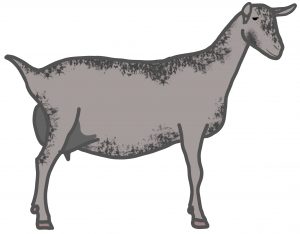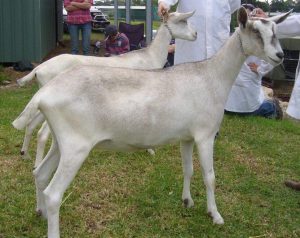Sable
HISTORY
Sable goats are derived from the Saanen breed which originated in Switzerland. They may be any color or combination of colors except white or light cream. Sables are the result of the interaction of recessive genes from the sire and from the dam. If the offspring has a dominant gene for white color, the animal is white and thus a Saanen and not a Sable. Color patterns can be complex; however, it appears that if the animal has two recessive genes, one from each parent, a colored coat is the result. Sable goats have various color patterns. Because the colored genetics were brought in with the original Saanen imports from Switzerland. Sables also have a darker skin colour than Saanens. Their darker skin compared to Saanens makes them no more prone to skin cancer than are other breeds while retaining all the Saanen’s superior characteristics.
BREED STANDARD
GENERAL APPEARANCE: (style & quality):Attractive dairy type, revealing vigour, femininity in does or masculinity in bucks, with harmonious blending and correlation of parts, showing no tendency to coarseness.
HEAD: Head slender, medium length, well balanced on neck, facial line dished or straight, skull broad between the eyes, polled or neatly disbudded. Eyes large and bright amber coloured. Pricked ears, medium size carried well above horizontal. Inside of ears preferably very dark tanned to black in colour. Black or dark coloured nose.
MOUTH: Well developed muzzle, broad lips, open nostrils.
NECK:Blending smoothly into the shoulder, with or without tassels, does long and slender, bucks fine and strong, not coarse.
BACKLINE: Strong, straight and horizontal from the withers to hips.
FOREQUARTERS: Lean, high withers, set well into the shoulders which should blend firmly into the body. Chest wide and deep in bucks, showing medium width and depth in does.
BODY (barrel): Wedge shaped, long barrel having well sprung ribs and a deep frame extending directly to the udder.
HINDQUARTERS: Gradual fall from the hips to tail, good width between hips and thurls. Rump broad and strong, pin bones wide and prominent.
LEGS: Straight and strong. Forelegs showing proportionate width to chest, hindlegs and hocks well apart. Hocks slightly bent when seen from the side. Pasterns short and strong, hooves sound and well-shaped.
UDDER: Broad attachment high at the rear and well forward in front, and no pocket. Not pendulous or unduly divided. Level sole, very softly textured. Skin colour near black (ashen).
TEATS: Of adequate size for ease of milking, well attached and distinct from the udder. Set well apart, pointing slightly forward and down, not outward.
TESTICLES: Scrotum well attached, relatively even and not divided or unduly pendulous. Carrying two testes.
RUDIMENTARY TEATS: Two, set wide apart, slightly to the fore and sides of the scrotum, and being of good size but not overdeveloped, unless the buck is milking.
SIZE: Does 81 cm (32 inches). Bucks 94cm (37 inches).
COAT: Short and smooth. Bucks may have a longer coat.
bulbous, ill-defined or unbalanced teats. Lack of milking capacity. Lack of dairy quality. Shallow body. Size differing substantially from ideal. Lack of masculinity in bucks. Divided, uneven or unduly pendulous scrotum.
DISQUALIFICATIONS: Pink skinned udder. Pendulous ears. Wry face. Obviously overshot or undershot jaw (side profile). Double or supernumerary teats. Double orifices. Undescended testicles in bucks, or one testicle only. Intersex.
COLOUR: Coat colour any colour or combination of colours, with the exception of the following, white,solid brown (Australian Brown), solid black (Australian Melaan),black with white Swiss markings (similar to British Alpine),brown with white Swiss markings (similar to Toggenburg). Splashing on body and badgering on the face may be present. Both male and females may have a dorsal stripe which can run over the withers and down the chest. Striping may be present on legs. Tan or dark skin covering 75% of the body.
DIFFERING FROM THE IDEAL (found and recognised): Horned. Raised bridge to nose. Uneven tassels. Longer hair along back and down the quarters. White coat with black skin acceptable but not ideal. Tan udder.
FAULTS: Low set ears. Weak or narrow chest. Roach or sway back. Steeply sloping rump. Cow hocks. Dropped pasterns. Splayed hooves. Poor hooves. Uneven gait. Fleshy, pendulous or unduly divided udder. Pocket in udder. Small, thin, large, bulbous, ill-defined or unbalanced teats. Lack of milking capacity. Lack of dairy quality. Shallow body. Size differing substantially from ideal. Lack of masculinity in bucks. Divided, uneven or unduly pendulous scrotum.
DISQUALIFICATIONS: Pink skinned udder. Pendulous ears. Wry face. Obviously overshot or undershot jaw (side profile). Double or supernumerary teats. Double orifices. Undescended testicles in bucks, or one testicle only. Intersex.

